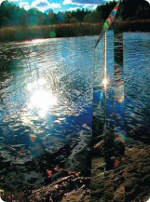Living Spaces: The Glasslands Collection
 The Glasslands Collection project by Canadian artist Mark Raynes Roberts was recently covered in an article by Living Spaces. The Natural Step Canada is proud to parter with the renowned artist on the unique art initiatve uniting art with nature. A new video has also been released highlighting the 10 sustainability themes showcased in the Glasslands Collection project.
The Glasslands Collection project by Canadian artist Mark Raynes Roberts was recently covered in an article by Living Spaces. The Natural Step Canada is proud to parter with the renowned artist on the unique art initiatve uniting art with nature. A new video has also been released highlighting the 10 sustainability themes showcased in the Glasslands Collection project.
***
Art can take many different forms and serve many different purposes. The artist’s journey lasts a lifetime and takes their work to new and unexpected places, with each new piece becoming a commentary not only on the world in which it is created, but on all that came before it. Such has been the experience of renowned Toronto artist and designer Mark Raynes Roberts, whose work has evolved in phases stretching back to an initial choice between jewellery and photography, all culminating in his latest concept: the GLASSLANDS Crystal Collection. The proposed project would bring ten crystal and glass sculptures to ten different beautiful outdoor locations, each one based on a theme relating to humanity and the environment.
The purpose, like the pieces themselves, is elegant in its simplicity: to provoke contemplation, to spur discussion, and to highlight the unmatched art that is nature. “I want my art to be educational and philanthropic,” says Raynes Roberts, who has a lifetime of experience working with crystal, gold and other materials for a variety of clients. Many of his glass and crystal projects have been award statues for such events as the Ethics in Action Awards for Ontario and the Globe & Mail 25 Transformational Canadians Awards, presented to such prominent figures as environmentalist David Suzuki, former prime minister Paul Martin and Research in Motion co-CEOs Jim Balsillie and Mike Lazaridis. These awards are for causes he believes in, but it is personal projects like GLASSLANDS that allow Raynes Roberts to express his pure philosophy and artistic vision.
Today that vision is one of the environment and our relationship to it, and this theme runs to the very core of the project: the material itself. Five of the sculptures will be cut from the highest quality lens crystal—the same used in telescopes that bring us images of distant galaxies and microscopes that reveal the inner workings of nature. The other five will be reclaimed glass, diverted from the landfills where so much like it sits: a reminder of the impact that we are making on the world around us.
“Take the prism of crystal as a lens to to look at the beauty of the planet,” says Raynes Roberts, who considered different ways to evoke nature with his work before he realized that simplicity was best—nature could do the job itself, he just had to put it into focus. He describes the lens as a metaphor, and the concept photography shows how the crystal will capture and refract its surroundings with such clarity that it loses definition and becomes an almost ghostly focal point. Like us, it would be nothing without its environment.
These photos were shot in scenic parts of Caledon with existing crystal work, and it served as the inspiration for the ten-piece GLASSLANDS series. Photography was once Raynes Roberts’ other love, but he gave it up to pursue jewellery and engraving until two years ago when he picked up a camera and discovered that the passion was still there, and that it would even compliment his other work. “I am just loving photography,” he says. “It brings back your creative juices.”
The proposed GLASSLANDS pieces are titled with themes that fit within the broader environmental concept: Creation, Balance, Fragility, Perspective, Footprint, Tree of Life, Window, One Change, Bridge and Harmony. Ultimately the goal is to promote education by associating scientists and activists with the works. “Art is a conduit to bring an expert voice,” says Raynes Roberts, who is currently seeking environmental organizations and green-friendly corporations to associate with the project.
The understated design of GLASSLANDS is the result of a long trend in Raynes Roberts’ career. He trained under master engraver Ronald Pennell and is skilled at the art of high realism—many of his works feature intricately detailed three-dimensional scenes, the product of hundreds of hours of labour—but over time his focus shifted to surrealism and, most recently, minimalism. He now strives to create art that “says everything in the simplest way,” and for such work there may be no better subject than nature.
Mark Raynes Roberts hopes to launch GLASSLANDS in the spring of 2012 and bring his unique vision for environmental awareness to the unmatched wilderness that surrounds us. The existing collection is on display at the Pond Gallery at the Alton Mill Arts Centre until May 29th. You can learn more about the project and watch a video presentation of the photography that inspired it at markraynesroberts.com.
- Log in to post comments

